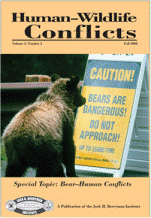Wildlife Damage Management, Internet Center for
Date of this Version
2008
Abstract
Human–wildlife interactions are not a series of random events. They are characterized by patterns of causal factors, and the scientific study of those patterns enables management plans to be developed, conflicts reduced, and the net benefits of wildlife, thus, enhanced. Unfortunately, however, there are some wildlife species that get caught up in human‒wildlife conflicts that are particularly difficult to resolve, even though the causal factors are well-known. Such conflicts commonly occur with wildlife species that use the same main food types as humans. In North America and Europe, the problem is exemplified by brown and black bears (Ursus arctos and U. americanus) that frequently come into conflict with humans who raise free-ranging livestock, keep bees, grow crops, build houses and roads, and camp out in bear habitats. It is, thus, highly appropriate that this issue of Human–Wildlife Conflicts focuses on human–bear interactions.


Comments
Published in Human-Wildlife Conflicts Volume 2, Number 2, Page 144, Fall 2008. Published and copyright by Jack H. Berryman Institute. http://www.berrymaninstitute.org/journal/index.html